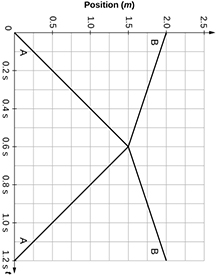| << Chapter < Page | Chapter >> Page > |
Which of the following statements is true about an inelastic collision?
(b)
Explain how the momentum and kinetic energy of a system of two colliding objects changes as a result of (a) an elastic collision and (b) an inelastic collision.

This figure shows the positions of two colliding objects measured before, during, and after a collision. Mass A is 1.0 kg. Mass B is 3.0 kg. Which of the following statements is true?
(a)
For the above graph, determine the initial and final momentum for both objects, assuming mass A is 1.0 kg and mass B is 3.0 kg. Also, determine the initial and final kinetic energies for both objects. Based on your results, explain whether momentum is conserved in this collision, and state whether the collision is elastic or inelastic.
Mass A (1.0 kg) slides across a frictionless surface with a velocity of 8 m/s in the positive direction. Mass B (3.0 kg) is initially at rest. The two objects collide and stick together. What will be the change in the center-of-mass velocity of the system as a result of the collision?
(a)
Mass A (1.0 kg) slides across a frictionless surface with a velocity of 4 m/s in the positive direction. Mass B (1.0 kg) slides across the same surface in the opposite direction with a velocity of −8 m/s. The two objects collide and stick together after the collision. Predict how the center-of-mass velocity will change as a result of the collision, and explain your prediction. Calculate the center-of-mass velocity of the system both before and after the collision and explain why it remains the same or why it has changed.
What is an elastic collision?
Two identical objects (such as billiard balls) have a one-dimensional collision in which one is initially motionless. After the collision, the moving object is stationary and the other moves with the same speed as the other originally had. Show that both momentum and kinetic energy are conserved.
Professional Application
Two manned satellites approach one another at a relative speed of 0.250 m/s, intending to dock. The first has a mass of , and the second a mass of . If the two satellites collide elastically rather than dock, what is their final relative velocity?
0.250 m/s
A 70.0-kg ice hockey goalie, originally at rest, catches a 0.150-kg hockey puck slapped at him at a velocity of 35.0 m/s. Suppose the goalie and the ice puck have an elastic collision and the puck is reflected back in the direction from which it came. What would their final velocities be in this case?

Notification Switch
Would you like to follow the 'College physics for ap® courses' conversation and receive update notifications?